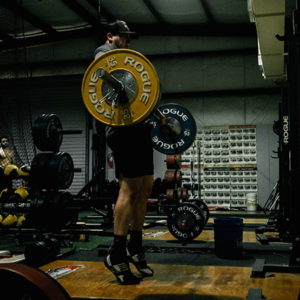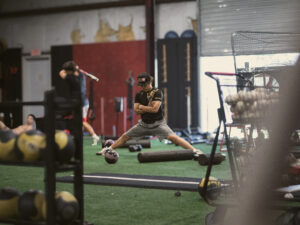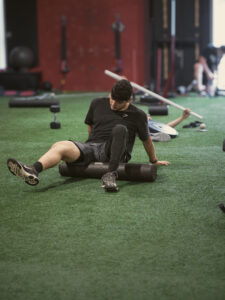One of the most important aspects for any hitter to develop is bat speed. The ability to build bat speed can be the difference between hitting a deep home run or a weakly hit grounder. Though many hitters focus on strength and agility, few understand the subtle nuances that can make all the difference when training to increase bat speed velocity. Improving bat speed requires a combination of proper mechanics, motor-control training, and a well-developed power-to-weight ratio. To increase your bat speed, hitters should focus on Olympic lifting to increase power being generated from the ground up; loading the back hip to increase torque in the swing, which allows for a transferring of maximum force into the front leg for added momentum, and not allowing the trunk to get over the front leg.
Once you implement the following tips and fixes into your training you will see dramatic improvements in your bat speed and hitting power.
Power-to-Weight Ratio and Explosive Strength for Bat Speed
Bat speed is not purely a function of raw strength—it’s a reflection of how efficiently the body can generate and transfer force through the kinetic chain with speed, coordination, and control. To maximize this process, hitters must develop a high power-to-weight ratio, meaning they can produce significant force relative to their body mass. This quality is what allows smaller athletes to generate elite bat speeds and what separates explosive hitters from those who rely solely on size or effort.
While traditional strength training improves the ability to produce force, it’s explosive strength—force produced quickly—that truly elevates bat speed. The swing is a high-velocity, rotational movement that demands near-instantaneous ground reaction force production, rapid hip and trunk rotation, and efficient segmental sequencing. Training methods that improve both peak force output and the rate of force development are the most effective for enhancing bat speed. These include Olympic lifting, plyometrics, and rotational medicine ball work.
This approach is strongly supported by research. Taniyama et al. (2021) showed that whole-body power outputs—particularly those measured through rotational medicine ball throw velocity—had strong correlations with swing velocity and exit speed in collegiate baseball players. Importantly, isolated strength tests did not show the same predictive power. Similarly, Avina et al. (2021) found that kinetic variables like pelvic velocity and ground reaction force contributed significantly to bat angular speed, reaffirming that the ability to generate and transmit force explosively across segments of the body is central to bat speed.
In the sections that follow, we’ll break down the most effective exercises and training modalities for developing explosive strength and optimizing power-to-weight ratio specifically for baseball hitters.
Power focused lifts
Training for bat speed is not unlike the training that pitchers go through to increase their pitching velocity. Both require a focus on explosive movements such as Olympic-lifting and plyometrics. As Hitters, it is about producing the maximum amount of energy possible by utilizing the lower body and upper body (the Kinetic Chain). The more power baseball players can generate through the use of triple extension of the ankle, knee, and hip and power that up through the kinetic chain through the barrel of the bat, the faster your bat speed and exit velocity will be. With that in mind let's focus on what specific exercises will help push your entire body and unlock your explosive strength potential.
3 position cleans

Olympic Lifting to build Explosive power for Pitchers and position players in baseball.
The 3-position clean—consisting of a hang clean, below-the-knee clean, and floor-position power clean—is one of the most effective compound lifts for developing explosive strength and full-body sequencing. Each segment of this lift targets a different part of the pull phase, requiring precise timing, triple extension (ankle, knee, hip), and upper-body coordination.
Why it matters for bat speed: The clean closely mimics the explosive kinetic chain pattern seen in a baseball swing. When performed correctly, it teaches the athlete to engage the posterior chain, develop rate of force production, and reinforce powerful hip extension—a key component in both hitting and throwing mechanics.
A study by Tamiya et al. (2021) found strong correlations between rotational medicine ball throw velocity and bat swing speed, suggesting that full-body explosive lifts targeting rotational and linear force production directly enhance hitting performance. While Olympic lifts are more linear, they lay the foundation for rotational sequencing when combined with med-ball work and swing-specific drills.
For best results, hitters should perform cleans under the supervision of a certified Olympic lifting coach or attend TopVelocity’s 2X Position Player Velocity Camp, where proper technique and progressive overload strategies are taught specifically for baseball athletes.
Plyometrics
Plyometric training is essential for developing the lower-body rate of force development (RFD) and improving the stretch-shortening cycle (SSC), which governs how quickly muscles can switch from eccentric (loading) to concentric (explosive) phases. For hitters, this quality is especially important, as the swing requires rapid, full-body acceleration beginning with a powerful lower-body push into the ground.
Plyometrics bridge the gap between general strength and sport-specific speed. Exercises like jump squats, lateral bounds, depth drops, and sprint take-offs improve lower-body explosiveness in vertical and horizontal planes, both of which contribute to hip rotation and stride force in the swing. When used in conjunction with Olympic lifting, plyometrics help athletes learn how to express force at high speeds—building not only power, but also reactive quickness.
One of the most effective drills for improving lower-body quickness and ground force efficiency is the Rapid Response drill, a staple in the TopVelocity system. This drill involves rapidly striking the feet into the ground in a quick, alternating rhythm, focusing on ground contact time and maximum intent per strike. Baseball players should perform Rapid Response at least once per week, using a 1:10 work-to-rest ratio for optimal recovery and neuromuscular adaptation.
The key to success with plyometric work—and especially with drills like Rapid Response—is intent. The goal is not simply to complete the movement, but to perform each rep with maximal energy and precision. The nervous system must be challenged with high-speed contractions to translate effectively to game-speed mechanics.
Scientific support:
Avina et al. (2023) demonstrated a strong relationship between ground reaction force (GRF) generated from the back leg and pelvic rotational velocity, both of which are critical for bat speed development. Punchihewa et al. (2021) further confirmed that peak GRF timing corresponds closely with peak pelvic acceleration, underscoring the importance of explosive leg actions in generating bat speed.
When performed consistently and with proper intent, plyometric training—particularly in conjunction with Olympic lifting—develops the neuromuscular speed and lower-body power that hitters need to increase bat speed and exit velocity.
Rotational Medicine Ball Throws
Plyometric training is essential for developing the lower-body rate of force development (RFD) and improving the stretch-shortening cycle (SSC), which governs how quickly muscles can switch from eccentric (loading) to concentric (explosive) phases. For hitters, this quality is especially important, as the swing requires rapid, full-body acceleration beginning with a powerful lower-body push into the ground.
Plyometrics bridge the gap between general strength and sport-specific speed. Exercises like jump squats, lateral bounds, depth drops, and sprint take-offs improve lower-body explosiveness in vertical and horizontal planes, both of which contribute to hip rotation and stride force in the swing. When used in conjunction with Olympic lifting, plyometrics help athletes learn how to express force at high speeds—building not only power, but also reactive quickness.
One of the most effective drills for improving lower-body quickness and ground force efficiency is the Rapid Response drill, a staple in the TopVelocity system. This drill involves rapidly striking the feet into the ground in a quick, alternating rhythm, focusing on ground contact time and maximum intent per strike. Baseball players should perform Rapid Response at least once per week, using a 1:10 work-to-rest ratio for optimal recovery and neuromuscular adaptation.
The key to success with plyometric work—and especially with drills like Rapid Response—is intent. The goal is not simply to complete the movement, but to perform each rep with maximal energy and precision. The nervous system must be challenged with high-speed contractions to translate effectively to game-speed mechanics.
Scientific support:
Avina et al. (2023) demonstrated a strong relationship between ground reaction force (GRF) generated from the back leg and pelvic rotational velocity, both of which are critical for bat speed development. Punchihewa et al. (2021) further confirmed that peak GRF timing corresponds closely with peak pelvic acceleration, underscoring the importance of explosive leg actions in generating bat speed.
When performed consistently and with proper intent, plyometric training—particularly in conjunction with Olympic lifting—develops the neuromuscular speed and lower-body power that hitters need to increase bat speed and exit velocity.
Back Leg Load and Hitting Mechanics
A properly loaded back leg is one of the most essential yet misunderstood components of elite swing mechanics. While many athletes emphasize hand speed or rotational torque, true bat speed begins with efficient energy generation and storage in the posterior chain, initiated by the back leg. This initial load phase sets the foundation for force production and sequencing throughout the entire swing.
Ground Force Development Through the Back Leg
During the stride phase, the hitter must create a stable yet dynamic base by applying force into the ground through the back leg. This is achieved through slight external rotation of the femur (hip joint) while keeping the back foot anchored. The pelvis should rotate slightly while the upper trunk remains closed, storing potential energy in the form of elastic tension across the hips and core.
As the front foot lands and the hitter transitions into rotation, the internal rotation of the back hip—coupled with explosive extension of the ankle, knee, and hip (triple extension)—drives the pelvis forward and initiates trunk acceleration. This hip rotation is not passive; it must be trained through specific strength and mobility work that builds stability and rotational capacity in the hip complex.
Coaching Insight:
A reliable indicator that the hitter has loaded properly is the sensation of the back leg “wanting to kick up” after the front foot lands and extends. This is a sign that the rear hip has effectively unloaded energy, transferring force through the pelvis and trunk. Hitters who fail to load properly often demonstrate premature hip rotation, insufficient torque, and weak front-leg bracing—all of which limit bat speed.
Transfer of Force to the Front Side
Loading is only part of the equation. To fully capitalize on the energy stored in the back leg, hitters must also have the ability to anchor and stabilize the front leg upon foot strike. The front side acts as a brake, allowing the force generated from the rear side to be redirected up through the torso and into the bat. Without this firm front-side block, much of the energy “leaks” forward, diminishing trunk rotation speed and limiting bat acceleration.
Scientific support:
Avina et al. (2021) found that anterior impulse from the back leg was a significant predictor of pelvic angular velocity (r² = 0.477, p = .027). In turn, pelvic velocity was a strong determinant of bat angular speed. This confirms that how well a hitter loads and drives off the back leg directly influences rotational velocity and ultimately bat speed.
Additionally, Punchihewa et al. (2021) observed that hitters with higher bat speeds demonstrated more effective sequencing of peak ground reaction forces—first from the back leg and then from a stabilized front leg. The timing and direction of force application during this loading phase were critical for maximizing bat acceleration.
Application Through Med Ball Drills
To help athletes develop a more powerful and efficient back leg load, the 2X Position Player Velocity Program and GFT Hitting Program incorporate specific med ball drills such as:
-
Step-back rotational scoop tosses
-
Split stance med ball throws
-
Load-and-fire drills with med ball counter-rotation
These drills train the athlete to maintain lower-half tension, build hip torque, and time rotational sequencing while minimizing upper-body compensation. They also allow for more reps without the high neural fatigue that comes from repeated high-intensity swings, enabling faster motor learning and refinement.
Proper back leg loading, when combined with an explosive hip rotation and a stable front-side block, forms the foundation for high-level rotational power and consistent bat speed. Without it, no amount of hand speed or bat path adjustment can fully unlock a hitter’s power potential.
Staying Closed: Maintaining Trunk Alignment for Maximum Separation
One of the most overlooked yet essential aspects of hitting mechanics is the ability to stay closed during the stride phase, maintaining rotational separation between the pelvis and upper trunk. “Staying closed” refers to delaying the opening of the front shoulder and upper torso while the hips begin to rotate toward the pitcher. This separation stores elastic energy and creates a whip-like effect through the core, maximizing bat speed and energy transfer at contact.
The Role of Trunk Separation in Rotational Acceleration
In a properly sequenced swing, the pelvis initiates rotation first, while the upper torso remains coiled. This creates a stretch across the oblique sling system and elastic tissues of the thoracolumbar fascia. As this elastic tension is released, the torso accelerates rotationally, allowing for greater trunk angular velocity and bat acceleration.
Prematurely flying open—where the front shoulder rotates toward the pitcher too early—reduces this separation and cuts off the energy buildup. This not only limits rotational acceleration but often results in upper-body compensations, loss of direction, and a less stable bat path.
Biomechanical reasoning:
The magnitude and timing of trunk separation are central to rotational energy development. The greater the differential (or “X-factor”) between the pelvis and the upper trunk at stride foot contact, the more elastic energy is stored. The later the trunk opens relative to the hips, the more efficiently this energy is transferred to the bat.
Scientific support:
Avina et al. (2021) reported a significant correlation between upper torso rotational velocity and bat speed (r = 0.832, p = .003), and noted that hitters who achieved greater separation between the pelvis and torso demonstrated higher bat angular velocities. Their findings confirm that staying closed during the stride phase directly enhances performance by increasing rotational speed through the trunk.
Motor Control Strategies and Drills
Staying closed is not just a matter of strength; it requires motor control, body awareness, and proper loading mechanics. Many athletes who “fly open” do so because they lack stability or coordination in the lower half and trunk. Training should therefore include exercises that reinforce directional alignment, rotational delay, and segmental timing.
Some of the most effective drills to train staying closed include:
-
Linear-on-knee med ball throws: Teaches directional force while resisting early torso rotation
-
Linear full-stride drills: Encourages proper stride alignment and upper-body control
-
Med ball counter-rotation throws: Builds motor control in the separation phase
-
Dry drills (no bat or load): Allows athletes to feel upper trunk coiling independently of the pelvis, helping internalize the sequence
In cases where hitters consistently fly open, coaching cues such as “keep the front shoulder closed longer” or “delay the chest” may help. For some athletes, experimenting with slight internal rotation of the front leg during the stride phase can also facilitate improved separation, provided that it doesn’t interfere with timing or front-leg stability.
Application to Injury Prevention
Beyond performance, staying closed also plays a role in injury prevention. When the torso opens prematurely, the upper body must compensate to generate force, placing additional stress on the shoulder, elbow, and lumbar spine. Maintaining rotational separation allows for smoother sequencing and reduces mechanical inefficiencies that often lead to overuse injuries in rotational athletes.
Upper-Body Sequencing: Linking Linear and Rotational Force to Maximize Bat Speed
One of the most misunderstood elements of the baseball swing is the role of upper-body sequencing—specifically, how the back arm interacts with trunk rotation to efficiently transfer force into the bat. While the lower body generates the majority of power, the upper body’s job is to convert and release that energy, not compensate for its absence. Poor sequencing can result in wasted energy, mechanical breakdowns, and increased injury risk—especially to the elbow and shoulder.
The Role of the Back Arm in Energy Transfer
In a properly sequenced swing, the back arm acts as a conduit, not a primary driver. As the lower half and trunk initiate rotation, the back elbow should move downward toward the back hip, then stay connected as it “rides” the hip into the zone. This allows the arm to deliver energy generated from the ground up without prematurely uncoiling or “casting” away from the body.
Many amateur hitters, however, become overly aggressive with the back arm, using it to pull the barrel into the zone. This not only compromises trunk rotation and timing, but also places excessive valgus stress on the elbow—particularly the ulnar collateral ligament (UCL). Over time, this kind of sequencing error can lead to chronic irritation or more serious elbow injuries.
Biomechanical concept:
The swing involves the integration of linear force from the lower body with rotational force through the trunk and shoulders. If the back arm acts too early or independently, it disrupts the segmental timing of the kinetic chain. The result is a swing driven by arms rather than hips and torso—a mechanically inefficient and injury-prone pattern.
Injury Prevention and UCL Load Management
Aggressive, disconnected upper-body mechanics often result in hyperextension or over-pronation of the lead arm and increased valgus torque on the back elbow. These compensations are especially dangerous in athletes with poor trunk strength or mobility, who rely on arm speed instead of full-body acceleration.
By allowing the back arm to remain connected to the trunk and rotate in concert with the hips, hitters reduce the need for excessive muscular effort and decrease joint-level stress. This is not only more efficient, but also significantly safer over time.
Supporting insight:
Although limited direct research exists on hitting-specific UCL strain, biomechanical studies in throwing (e.g., Fleisig et al., 1999) and high-speed rotation confirm that poor sequencing and lack of kinetic chain transfer increase the torque on distal joints. In hitting, this likely presents as overuse injuries to the elbow, shoulder, and thoracic spine in athletes who disconnect their upper bodies from the kinetic chain.
Upper-Body Sequencing: Linking Trunk Power to the Bat
While the lower half generates the foundation of rotational energy in the swing, it is the upper-body sequencing—specifically the relationship between the trunk and back arm—that determines whether that energy is successfully transferred into the bat. Poor sequencing can compromise timing, reduce bat speed, and increase injury risk to the elbow and shoulder. Optimal upper-body sequencing ensures that the trunk leads the movement, the arms stay connected, and force flows seamlessly through the kinetic chain.
Trunk-Led Rotation and Arm Connection
In an efficient swing, the trunk begins to rotate before the back arm activates, allowing the upper body to multiply and guide the force generated from the hips. A common breakdown occurs when hitters attempt to “pull” the bat with the back arm too early. This creates a disconnect between the core and the arm, often resulting in reduced bat speed and increased joint stress, particularly at the elbow (such as UCL strain).
Instead, athletes should be trained to allow the elbow to drop and “ride the hip” through the zone. This sequence—where the back elbow stays tight to the body and follows the rotation of the hips—ensures optimal timing and leverages the elastic energy stored across the core.
Applied Drills from the GFT Hitting Program
The following three drills from the GFT Hitting Program are designed to reinforce proper trunk-led sequencing and build timing between the hips, trunk, and arms:
1. Linear on Knee Med Ball Drill
This drill isolates the trunk and arm from a kneeling position to emphasize upper-body sequencing without relying on the lower half. The athlete begins with the back leg down and the front leg forward in a slightly closed position. The movement initiates with hip drive, followed by shoulder separation, and finishes with the back elbow dropping down to engage with the hip as the front arm guides the med ball.
This movement pattern helps athletes feel the trunk pulling away from the back hip, loading elastic tension before releasing it into rotation. It forces core engagement and improves elbow-to-hip connection—critical for reducing arm dominance in the swing.
2. Linear Full Stride Med Ball Drill
In this progression, the athlete works through a full stride, building from the ground up. After lifting the front leg and loading the back hip, the front foot lands in a slightly closed position as the back hip rotates. The key is to create separation between the back hip and back scapula, maintaining coil before releasing the elbow to connect with the hip and drive the med ball forward.
This drill reinforces the timing of upper-body engagement in relationship to lower-body rotation. It trains athletes to delay arm action until the trunk has initiated and committed to rotational velocity.
3. Linear Momentum Med Ball Drill
The most dynamic of the three, this drill adds momentum to challenge sequencing under motion. The athlete falls forward into the stride, timing their load and hip drive with the landing of the front leg. As the hips open, the trunk resists, loading tension across the obliques and thoracolumbar fascia. Only once this tension peaks does the back elbow drop into the hip, transferring energy into the med ball.
The added momentum demands precise coordination and balance, simulating real swing conditions and testing the athlete’s ability to stay connected under dynamic loading.
Why These Drills Matter
Each drill focuses on trunk-first rotation followed by elbow-to-hip engagement, building the neuromuscular patterns necessary to avoid “arming the swing.” When trained consistently, these drills:
-
Improve trunk-to-arm timing
-
Increase segmental acceleration
-
Reduce stress on the shoulder and elbow
-
Increase the likelihood of a linear bat path guided by the hips, not the hands
Proper upper-body sequencing ensures that the energy generated by the lower half is transferred efficiently, with minimal energy loss and maximum mechanical integrity. These principles, reinforced through the GFT Hitting Program drills, help athletes generate elite-level bat speed while preserving long-term durability.
Bonus Tip - Functional Flexibility: Building Mobility That Translates to Rotational Power
While strength, sequencing, and power development often take center stage in bat speed training, functional flexibility—or mobility—plays a critical and often underappreciated role. Functional flexibility refers to an athlete’s ability to move a joint through a full range of motion (ROM) with strength and control. In the context of hitting, it’s not enough to be flexible in a passive sense; the athlete must be able to access that range during high-speed, load-bearing movements like the swing.
Why Functional Flexibility Matters for Bat Speed
Elite bat speed requires the body to rotate explosively through the hips, spine, and shoulders while maintaining balance and alignment. If an athlete lacks mobility in any key joint segment—particularly the hips or thoracic spine—they will struggle to create separation, store elastic energy, and rotate efficiently.
For example:
-
Limited hip internal rotation on the back leg restricts loading and coil
-
Poor thoracic spine rotation reduces trunk separation and rotational speed
-
Tight hip flexors or hamstrings can limit stride length and compromise ground force transfer
When these restrictions exist, the body finds compensation patterns—often overusing the lumbar spine, pulling with the arms, or flying open too early. These compensations not only reduce performance but also elevate injury risk.
Scientific support:
Scher et al. (2010) found that pitchers with reduced hip and shoulder ROM were significantly more likely to experience shoulder injuries. While this study was focused on throwing, the same principle applies to high-speed rotational hitting: poor mobility disrupts kinetic chain efficiency and increases stress on vulnerable structures. Similarly, Taniyama et al. (2021) noted that bat speed was strongly influenced by how well hitters could coordinate rotation through the hips and trunk—coordination which depends on accessible mobility under load.
Developing Functional Flexibility: The Strength-Mobility Connection
True mobility must be developed under tension and through the athlete’s full usable range. Static stretching may help prepare joints temporarily, but it doesn’t improve strength at end ranges or support high-speed rotational output.
To build functional flexibility:
-
Prioritize dynamic mobility routines that mimic hitting patterns
-
Train full ROM in compound lifts (e.g., deep squats, split squats, overhead press)
-
Integrate controlled articular rotations (CARs) for joint capsule training
-
Use isometric holds in stretched positions to build end-range strength
-
Program rotational med ball throws and drills through expanded ranges
A foundational principle in the GFT Hitting Program is combining static flexibility work with strength training through full ranges of motion. For instance, athletes may perform static hip openers before a session, then reinforce that mobility with rotational med ball throws or deep lunge-to-rotation drills. This layered approach ensures that mobility gains are functional and retained over time.
When Mobility Becomes a Performance Bottleneck
For athletes who demonstrate strength but still struggle to rotate or sequence efficiently, mobility restrictions are often the root cause. Rather than prescribing more drills or more swings, coaches should assess hip and thoracic spine mobility, shoulder external rotation, and ankle dorsiflexion. Restoring mobility in these areas can immediately improve movement quality and kinetic chain efficiency.
Functional flexibility is not optional for high-level performance—it is foundational. It allows athletes to access and apply the full potential of their strength and power without compensatory movements. By developing mobility that is usable, stable, and explosive, hitters create the platform for long-term durability and sustained bat speed gains.
Recap: How to Increase Bat Speed
Bat speed is one of the most critical components of offensive performance in baseball. Whether the goal is hitting for power, increasing exit velocity, or simply staying competitive at higher levels of play, bat speed is a foundational metric—and it’s trainable.
Increasing bat speed requires a comprehensive approach. Strength alone is not enough. True progress comes from integrating:
-
Explosive strength training (e.g., Olympic lifting, plyometrics)
-
Rotational power development (e.g., med ball throws, Russian twists)
-
Mechanical precision (proper sequencing, timing, and staying closed)
-
Functional mobility (active range of motion in hips, spine, and shoulders)
These elements work synergistically. Explosive power without mobility limits range and control. Great mechanics without strength reduces impact. Long-term progress requires all systems to be developed and aligned.
The methods outlined in this article are the result of over fifteen years of testing and refinement through the 2X Position Player Velocity Program and the Ground Force Torque (GFT) Hitting Program. We’ve seen hitters transform their bat speed by training smarter—not just harder—using these systems. They're built on biomechanics, motor control principles, and research-backed strength development, not guesswork or trends.
If you're serious about unlocking the next level of performance, it’s time to stop relying on feel and start training with purpose. You don’t need to be bigger—you need to move better, rotate faster, and build the explosiveness to deliver power when it counts.
To learn more about how to apply this training in your own development, contact us at (985) - 315-3130. We’ll help you build a personalized plan to increase your bat speed, refine your mechanics, and elevate your game.






